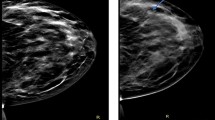Abstract
Background
The purpose of this study was to evaluate the diagnostic value and clinical significance of three-dimensional MR imaging of the breast in patients with mammographically detected suspicious microcalcifications.
Methods
Forty patients with suspicious microcalcifications on mammography were evaluated with three-dimensional MR imaging. MR findings were grouped mainly by distribution of abnormal enhancement (linear, focal-clumped, segmental-clumped, segmental-stippled and diffuse-stippled). These findings were compared with the mammography findings according to the criteria of the Breast Imaging Reporting and Data System (BI-RADS) and histopathologic data.
Results
Twenty patients had proven malignancies, most frequently ductal carcinomain situ. For all the cases, linear (100%) and segmental-clumped type (100%) enhancement on MR imaging showed a significantly higher risk for malignancy. Diffuse stippled type (7%) and no enhancement (0%) on MR imaging indicated the lowest possibility of malignancy. 3D-MR imaging showed a sensitivity of 90%, a specificity of 95% and an overall accuracy of 93% in this study.
Conclusions
Three-dimensional MR imaging of the breast can more accurately diagnose ductal carcinomain situ. Combined with mammography, this procedure is useful for reducing the number of false-positive biopsies and helpful for deciding the better management of patients with mammographically detected suspicious microcalcifications.
Similar content being viewed by others
Abbreviations
- DCIS:
-
Ductal carcinomain situ
- MIP:
-
Maximum intensity projection
- MPR:
-
Multiplanar reconstruction
- MLO:
-
Mediolateral oblique
- CC:
-
Craniocaudal
References
Stamper PC, Margolin FR: Ductal carcinoma in situ: The mammographer’s perspective.AJR 162:585–591, 1994.
Baker JA, Kornguth PJ, Floyd CEJ: Breast imaging reporting and data system standardized mammography lexicon: Observer variability in lesion description.AJR 166:773–778, 1996.
Ciatto S, Cataliotti L, Distante V: Nonpalpable lesions detected with mammography: Review of 512 consecutive cases.Radiology 165:99–102, 1987.
Hall FM, Storella JM, Silverstone DZ,et al: Nonpalpable breast lesions: Recommendations for biopsy based on suspicion of carcinoma at mammography.Radiology 167:353–358, 1988.
Liberman L, Abramson AF, Squires FB,et al: The breast imaging reporting and data system: Positive predictive value of mammographic features and final assessment categories.AJR 171:35–40, 1998.
Boetes C, Barentsz JO, Mus RD,et al: MR characterization of suspicious breast lesions with a gadoliniumenhanced turboFLASH subtraction technique.Radiology 193:777–781, 1994.
Kaiser WA, Zeitler E: MR imaging of the breast: Fast imaging sequences with and without Gd-DTPA.Radiology 170:681–686, 1989.
Stack JP, Redmond OM, Codd MB,et al: Breast disease: Tissue characterization with Gd-DTPA enhancement profiles.Radiology 174:491–494, 1990.
Orel SG, Schnall MD, LiVolsi VA,et al: Suspicious breast lesions: MR imaging with radiologic-pathologic correlation.Radiology 190:485–493, 1994.
Stamper PC, Herman S, Klippenstein DL,et al: Suspect breast lesions: Findings at dynamic gadoliniumenhanced MR imaging correlated with mammographic and pathologic features.Radiology 197:387–395, 1995.
Gilles R, Zafrani B, Guinebretiere JM,et al: Ductal carcinoma in situ: MR imaging-histopathologic correlation.Radiology 196:415–419, 1995.
Heywang-Köbrunner SH: Contrast-enhanced magnetic resonance imaging of the breast.Invest Radiol 29:94–104, 1994.
Orel SG, Mendonca MH, Reynolds C,et al: MR imaging of ductal carcinoma in situ.Radiology 202:413–420, 1997.
Rubens D, Totterman S, Chacko AK,et al: Gadopentetate dimeglumine-enhanced chemical-shift MR imaging of the breast.AJR 157:267–270, 1991.
Gilles R, Meunier M, Lucidarme O,et al: Clustered breast microcalcifications: Evaluation by dynamic contrast-enhanced subtraction MRI.J Comput Assist Tomogr 20:9–14, 1996.
Westerhof JP, Fischer U, Moritz JD,et al: MR imaging of mammographically detected clustered micro-calcifications: Is there any value.Radiology 207:675–681, 1998.
Harms SE, Flamig DP, Hesley KL,et al: MR imaging of the breast with rotating delivery of excitation off resonance: Clinical experience with pathologic correlation.Radiology 187:493–501, 1993.
Pierce WB, Harms SE, Flamig DP,et al: Three-dimensional gadolinium-enhanced MR imaging of the breast: Pulse sequence with fat suppression and magnetization transfer contrast. Work in progress.Radiology 181:757–763, 1991.
Soderstrom CE, Harms SE, Copit DS,et al: Three-dimensional RODEO breast MR imaging of lesions containing ductal carcinoma in situ.Radiology 201:427432, 1996.
American college of radiology (ACR): Breast imaging reporting and data system (BI-RADS™). Third edition ed. Reston, VA, ACR, 1998.
Rosner D, Bedwani RN, Vana J,et al: Noninvasive breast carcinoma: Results of a national survey by the American College of Surgeons.Ann Surg 192:139–147, 1980.
Smart CR, Myers MH, Gloeckler LA: Implications from SEER data on breast cancer management.Cancer 41:787–789, 1978.
Fisher E, Costantino J, Fisher B,et al: Pathologic findings from the national surgical adjuvant breast project (protocol 4): Discriminants for 15-year survival.Cancer 71:2141–2150, 1993.
Harris JR, Lippman ME, Veronesi U,et al: Breast cancer.N Engl J Med 327:319–328, 1992.
Holland R, Hendriks JHCL, Verbeek ALM,et al: Clinical practive: Extent, distribution, and mammographic/histological correlations of breast ductal carcinom in situ.Lancet 335:519–522, 1990.
Stamper PC, Connolly JL: Ductal carcinoma in situ of the breast: Correlation between mammographic calcification and tumor subtype.AJR 159:483–485, 1992.
Boetes C, Mus RDM, Holland R,et al: Breast tumors: Comparative accuracy of MR imaging relative to mammography and US for demonstrating extent.Radiology 197:743–747, 1995.
Lagios MD, Margolin FR, Westdahl PR,et al: Mammographically detected duct carcinoma in situ: Frequency of local recurrence following tylectomy and prognostic effect of nuclear grade on local recurrence.Cancer 63:618–624, 1989.
Fisher B, Anderson S, Redmond CK,et al: Reanalysis and results after 12 years of follow-up in a randomized clinical trial comparing total mastectomy with lumpectomy with or without irradiation in the treatment of breast cancer.N Engl J Med 333:1456–1461, 1995.
DiBiase SJ, Komarnicky LT, Schwartz GF,et al: The number of positive margins influences the outcome of women treated with breast preservation for early stage breast carcinoma.Cancer 82:2212–2220, 1998.
Author information
Authors and Affiliations
About this article
Cite this article
Nakahara, H., Namba, K., Fukami, A. et al. Three-dimensional mr imaging of mammographically detected suspicious microcalcifications. Breast Cancer 8, 116–124 (2001). https://doi.org/10.1007/BF02967490
Received:
Accepted:
Issue Date:
DOI: https://doi.org/10.1007/BF02967490




